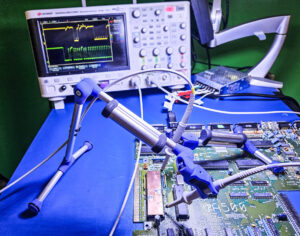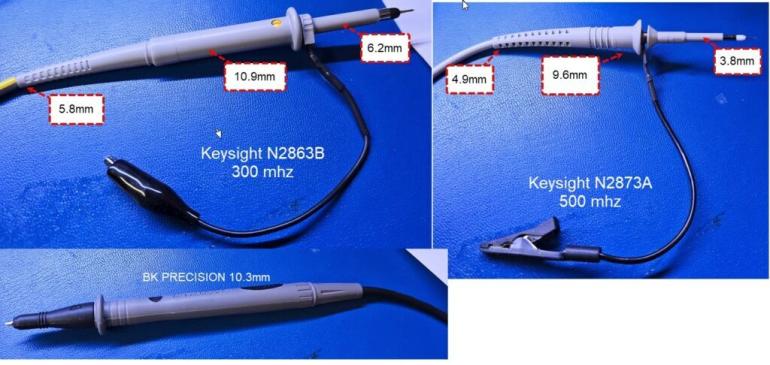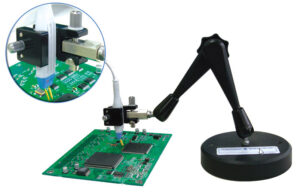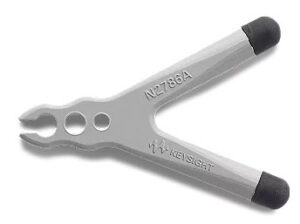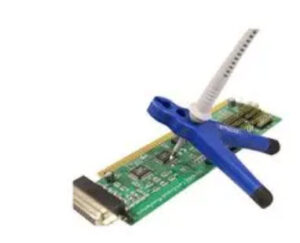Hands-Free Debugging: Reviewing Gisler Precision’s Probe Holders
Disclaimer: While I purchased these myself at full price, Gisler did pay for shipping. This is my own opinion.
If you’ve ever tried to hold multiple scope probes steady during debugging, you know how frustrating it can get. I tested three models from Gisler Precision to see which ones are worth adding to the workspace and how they compare to other options.
Getting Hands-Free with Probes
Trying to monitor multiple signals on a live board quickly becomes a mechanical challenge. Holding two probes steady while operating the scope isn’t practical, and precision goes out the window. More than once, I’ve had to call in help, usually my wife, to press the run/stop button while I held everything in place.
I’ve tried makeshift setups, but they never feel reliable. When contact matters and slipping could short something out, a proper probe holder isn’t just helpful—it’s necessary.
Getting Probes Under Control
A probe holder has one job: hold your probe exactly where you put it. That sounds simple, but when you’re working on a powered board, a small slip can short adjacent pins or dump a high-current rail straight to ground. It’s an easy way to fry your DUT. Ask me how I know? Due to sloppy probing, I once shorted two pins on a logic analyzer board, it’s never been the same since.
With a solid holder, you get hands-free contact that doesn’t drift. That means safer, cleaner, more repeatable measurements, and no need to babysit the probe while trying to watch the scope.
The good ones hit three marks: stability, so the probe doesn’t move; adjustability, so you can reach into tricky spots; and precision, so you can touch a single IC pin without risk of slipping. If it can’t do all three, it’s not helping.
Gisler Precision probe holders from probeholder.com.
(see Creative Commons CC-BY-SA-2.5 by Andrew Bossi)
Gisler Precision is a small company based in Arth, Switzerland, run by Damian Gisler. The attention to detail in the design reflects a clear commitment to quality and thoughtful engineering. This fits with Switzerland’s history in watchmaking, medical devices, precision machining, and rail systems, all fields where accuracy and consistency are expected.
The bluish color of the joints also match my 3M anti-static mat perfectly!
All three versions feature the same basic components. You’ve got 10mm (aluminum?) hollow tubes, a high-quality textured plastic to connect the pieces, the probe holder attachment, a cable management clip, and then some type of non-slip base.
Let’s look at each model individually.
Probeholder S aka the small one ($54 USD)
The small one is by far the least impressive. It doesn’t feel like much in hand, lightweight and a bit underwhelming at first. The most impressive thing about it is the probeholder spring-loaded mechanism shared by all models, which holds probes very securely. It’s a tight fit, and I like it. There are minimums and maximums for probe body dimensions, so make sure you look at the datasheets on the site.
For scale, my hands are average size for a middle-aged man. Unfortunately, no banana for scale this time.
Without the optional clip-on weight (pictured on the right), there’s barely enough mass to maintain contact. Rotating the weight lets you apply pressure where it’s needed most, helping keep the probe securely on the IC pin. I highly recommend the optional clip on weights, which apply more downward pressure. You can rotate the weight around to add it where you need it.
As you can see from this image, I don’t love that the holder sits right on top of my DUT. I suppose I could play with the placement of it.
My consensus is that the small one WORKS, but I’m not sure I’d place an international order for that one. I’d like to compare it to the Pico above, and I’ll modify this review if I do so.
Probeholder L aka large ($100 USD)
Now in the foreground, you can see the large one added on the left. This one uses the same base as the smaller version but adds two key upgrades: a longer articulated arm for reach and a two-axis joint at the probe holder for better probe alignment. I really can’t stress enough that this stuff just works, position it where you need it, and it says in place.
Probeholder X aka extra large ($180 USD)
As with many things in life, the most expensive options often deliver the best results, and there’s usually a good reason for it. I don’t think this is an exception here. And maybe it’s just the American in me, but the heavy duty solid base of the X model makes this much more substantial, and likely just much more useful to me. The X adds an additional joint just above the base, with a knob to tighten the joint. I prefer solid adjustment even if I don’t find the other joints lacking without it.
The X seems to be the flagship tool, and when I went searching for a probe holder, this is exactly what I envisioned. It’s solid, easy to position, and built for serious use.
Probe compatibility
Before I ordered these, I really wanted to make sure that they’d be compatible with the probes that I already own. I checked with Damian, who confirmed compatibility, and I tested it myself to be sure. The probe shaft diameter needs to be 4-12mm. Here are some common measurements on my probes. There’s also a minimum length requirement of around 20mm, which is noted in the datasheets on the site. See the datasheets.
Value
It’s not lost on me that between the price of the probe holders, high international shipping costs, new tariffs that buying these things comes at a cost. You’re talking about spending a few hundred dollars. I haven’t used them extensively enough to know if the ROI is truly there. But here’s what I know — I needed to probe two signals simultaneously, while playing with the scope controls. Previously, I really had no other option. These things solved my problem and now I can get on with my Amiga project, and that’s definitely worth something!
I did some basic research on other alternatives, which you’ll find below.
The Yokogawa 701919 Probe stand comes up as an option.
Even getting a clear price is tricky, but it looks to be around $895. I haven’t seen any reviews, and I’m not eager to spend that much only to be disappointed. I’ve been buying test equipment for over twenty years, but I still haven’t fully figured out the market. Sometimes a high price really does mean top-tier gear, my Keysight MSO-X 2024A is a perfect example. So. Worth. It. But a big price tag doesn’t always mean quality. Sometimes it just means you overpaid!
I’ve also seen the Keysight N2787A probe holder coming in at an eye-watering $1238. Is that just a Yokogawa relabeled? Sure looks like it!
Then there are the two-leg probe positioners including the:
- Keysight N2786A for about $100.
- Pico TA102 for about $33.
But those two-leg options look fairly rudimentary. Maybe they work. I’m willing to try a $33 flyer.
Have you tried one? Please let me know in the comments below!
Final Thoughts
If you’re into electronics as a hobby, there comes a point when better tools just make everything easier. Not because you’re chasing lab-grade perfection, but because they help you focus on the work instead of fighting the setup. A good probe holder won’t transform your bench overnight, but it will make debugging less awkward and more repeatable.
Out of the three, the XL model is the one I keep reaching for. It’s sturdy, easy to position, and feels like something built for real use. The large version comes close and makes a lot of sense if you’re adding a second arm or want something more compact. The small version gets the job done but really benefits from the extra weight.
None of these are cheap, but they’re one of those upgrades you appreciate every time you power up the scope. If you’re looking to improve your setup in a way that actually shows up in use, this is a great place to start.
The post Hands-Free Debugging: Reviewing Gisler Precision’s Probe Holders appeared first on techtravels.org.




